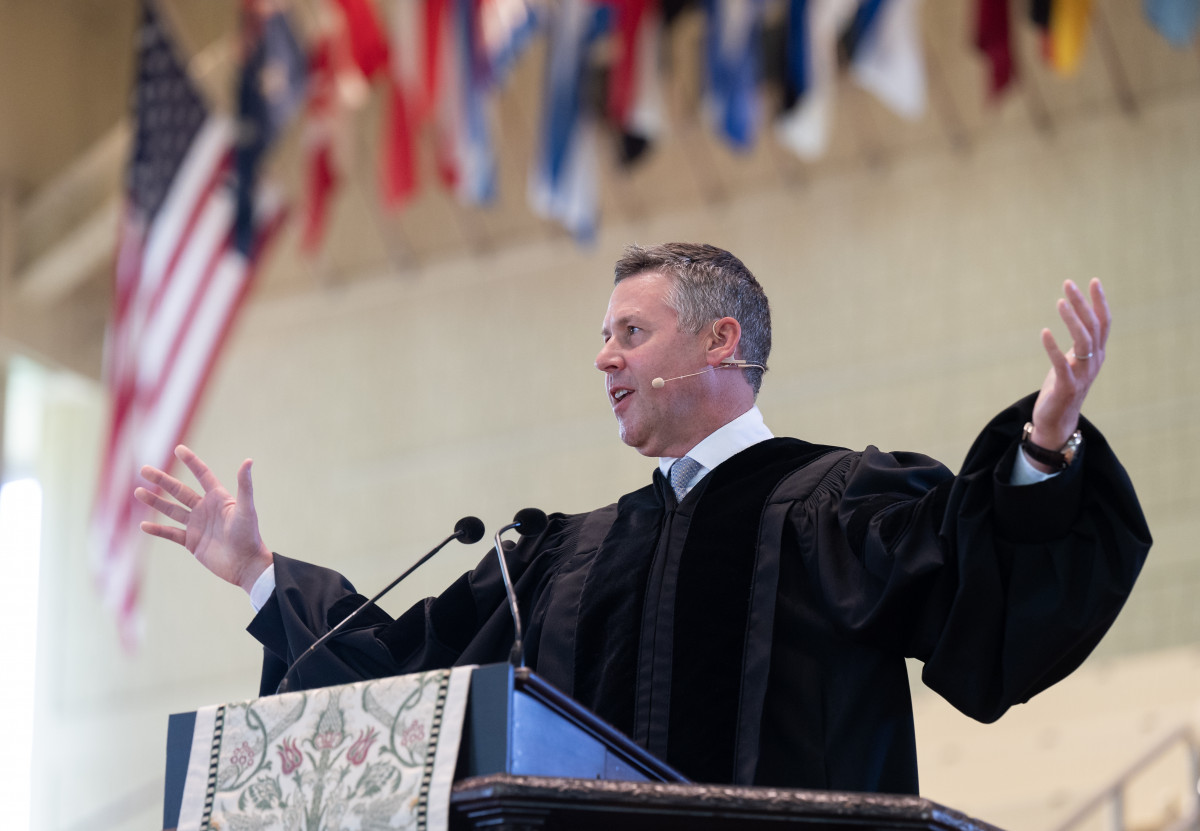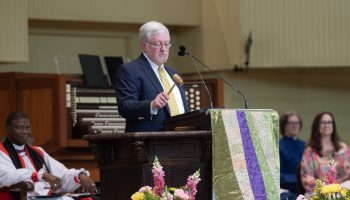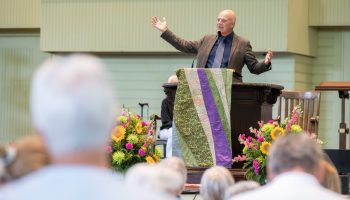
The Rev. Richard Kannwischer delivers his sermon “What I Got Wrong About Faith” Sunday in the Amphitheater.
“What happens at Christmas is not just sentiment or story; it is wholly and completely an unexpected surprise,” said the Rev. Richard Kannwischer at the 9:15 a.m. Tuesday morning worship service in the Amphitheater. “The virgin birth was not just God coming into the natural order. It was the birth of the new creation.”
Kannwischer’s sermon title was “What I Got Wrong About Christmas,” and the scripture reading was Luke 1:26-34. His topic was “Because I Believe in the Virgin Birth, I Will be Available for God to Surprise Me.”
There was a small congregation, he said, that was slowly pulling itself into the digital age. They finally got a word processor and instead of re-typing everything, they learned the joys of cut and paste. One time there were two funerals, one for Mary and one for Edna.
At the funeral service, the congregation was reading the Apostle’s Creed and found, “(Jesus) conceived by the Holy Spirit, born of the virgin Edna.” Find and replace had found and replaced every mention of Mary.
Kannwischer grew up in a small Presbyterian church. At Christmas the pastor would preach that the virgin birth did not really happen, and at Easter he would preach that the resurrection was just a metaphor.
“In the United Kingdom, 40% of the people don’t believe that Jesus lived, and 70% don’t believe in the virgin birth,” he said. “But at Cambridge University, by a process called parthenogenesis, there was a virgin birth of fruit flies.”
He continued: “We are scientifically able to do a virgin birth, but we are jettisoning virgin birth in our faith. An Australian theologian commented, ‘Christians believe in the virgin birth of Jesus and atheists believe in the virgin birth of the universe. Choose your miracle.’ Which is more plausible?”
While he was in seminary, Kannwischer listened to a debate between theologians Karl Barth and Emil Brunner about the virgin birth. “I went into the debate a skeptic,” Kannwischer said, “but I came away understanding the virgin birth had to be true. God was giving birth to the new creation.”
The Luke text in the New Revised Standard Version says that Mary was “perplexed” when the angel Gabriel told her she would have a son. The New International Version says that Mary was “greatly disturbed.”
“What the angel had to say is so shockingly impossible, it should be disturbing and cause wonder,” Kannwischer said. “We want to plan for Christmas when we need to be surprised by God beginning the new creation through us and in us.”
He continued, “Because I believe in God the Father and I trust his adoption and inheritance, I am available for God to surprise me through virgin birth.”
The name Mary comes from the Hebrew “Miriam,” which means “rebellion.”
“God gives Mary unexpected grace to begin the rebellion of the new creation. She was available for God to surprise her,” Kannwischer said.
He challenged the congregation to think about what kind of being they want God to be. If Mary wanted God to be a being she could control and put in a box, then the new creation could not be.
“I just can’t do that,” Kannwischer said.
Kannwischer told a story about a house church in Afghanistan that Peachtree Presbyterian Church was in partnership with just before the fall of Kabul. The members of the church had just gotten their identity cards stamped with the designation “Christian,” and they knew they would be killed by the new regime.
The people of the house church reached out to partners at Peachtree for prayer and any assistance they could provide.
In Atlanta, there is a group called the Atlanta Friendship Initiative, where Black people pair with Caucasians to get to know each other and hang out together. Kannwischer had paired with the Rev. Raphael Warnock, now a U.S. Senator, so he called Warnock’s office to see if there was any way to get help.
There was not much hope. The house church members were near the airport gate when a bomb went off. No one knew if they were alive or dead.
Kannwischer went on with his life that day and took his daughter to Wake Forest University for a college tour. While he was there, he got a call that the U.S. military had come to the house for the church members; they escaped to Germany and then came to the United States.
Kannwischer asked the congregation: “Are you available for the God of the universe to surprise you, or do you put God in a box that does not do parthenogenesis?”
He continued, “Mary knew the angel’s announcement was an utter surprise. How dare we think we are too sophisticated to believe that? God is still in the surprise business. This is not just a story, it is history. God did an unprecedented thing at Christmas and launched a new creation.”
The Rev. Mary Lee Talbot, Ph.D., author of Chautauqua’s Heart: A History of the Chautauqua Literary and Scientific Circle, presided. The Rev. Cynthia Strickland, a past president of the Presbyterian Association of Chautauqua, read the scripture. The prelude, “Es ist ein Ros’ entsprungen,” by Johannes Brahms, was played by Owen Reyda, organ scholar, on the Massey Memorial Organ. For the anthem, the Motet Choir sang “Spotless Rose,” music by Ola Gjeilo, text from the 16th-century German, translated by Catherine Winkworth. The choir performed a cappella under the direction of Joshua Stafford, director of sacred music and the Jared Jacobsen Chair for the Organist. Stafford played “Bring a Torch, Jeanette Isabella,” by Keith Chapman for the postlude on the Massey Organ. Support for this week’s services and chaplaincy is provided by the Robert D. Campbell Memorial Chaplaincy and the Mr. and Mrs. William Uhler Follansbee Memorial Chaplaincy.




